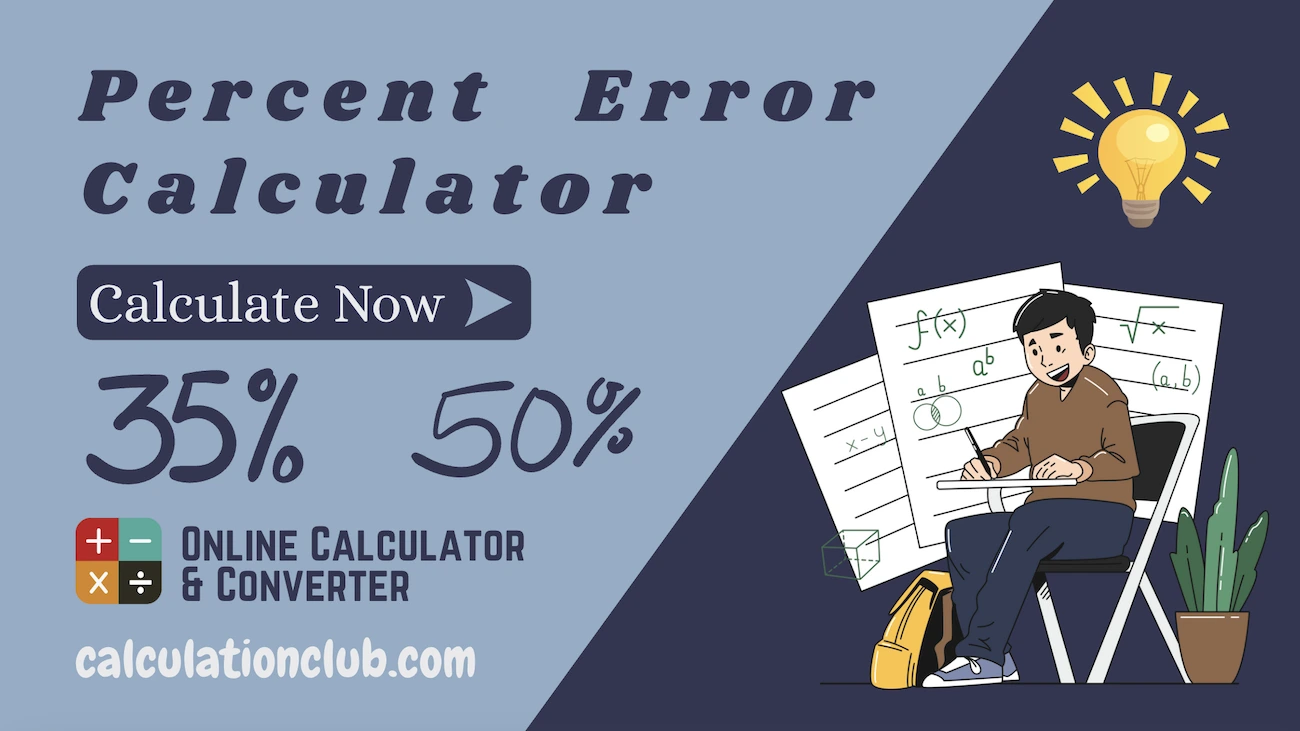Percent Error Calculator
The Percent Error Calculator is a free and easy-to-use online tool that helps you quickly calculate the percent error between a measured (or observed) value and an actual (or true) value. It also shows step-by-step calculations, making it ideal for learning, verifying answers, and quick reference—all available on CalculationClub.com.
Simply enter the measured value and the actual value, and the Percent Error Calculator will compute the percentage error. For example, inputting a measured value of 48 and an actual value of 50 will give you a 4% error.
In addition to the result, the calculator provides a clear, step-by-step explanation of how the percent error is calculated. You can also toggle the visibility of steps for a deeper understanding and greater flexibility when working with percentage error calculations.
How to Use the Online Percent Error Calculator?
- Enter the Observed Value
Start by entering the observed (measured) value in the Observed Value field — this is the value obtained from your experiment or measurement. - Enter the True Value
Next, input the true (actual) value in the True Value field — this is the correct or accepted reference value. - Click “Calculate”
Click the “Calculate” button to compute the percent error between the observed and true values. The result will appear instantly. - View or Hide Steps
Click “Show Steps” to see a detailed explanation of how the percent error was calculated. Choose “Hide Steps” for a simplified view. - Reset for a New Calculation
Click the “Reset” button to clear all fields and start a new percent error calculation with different values.

Percent Error Calculator
What is a Percent Error Calculator?
A Percent Error Calculator is a quick and user-friendly online tool that helps you determine the accuracy of a measured or observed value compared to the actual or true value. Whether you’re working on scientific experiments, financial estimates, or academic assignments, this calculator delivers instant results along with step-by-step explanations for better clarity and learning.
What is Percent Error?
Percent Error measures how far an observed (measured) value is from the true (actual) value, expressed as a percentage of the true value. It’s commonly used in science, engineering, and math to indicate the accuracy of experimental or estimated results.
It shows the size of the error in relation to the correct value. The formula is:
Percent Error = $\frac{\lvert \text{Observed Value} – \text{True Value} \rvert}{\lvert \text{True Value} \rvert} \times 100$
What is Absolute Error?
Absolute Error is the actual difference between the observed value and the true value, regardless of direction (i.e., it’s always positive).
Absolute Error = | Observed Value – True Value |
It gives a direct measure of the error in the same units as the original values.
What is Relative Error?
Relative Error expresses the absolute error as a fraction of the true value. It gives a sense of how significant the error is relative to the correct value.
Relative Error = $\frac{\lvert \text{Observed Value} – \text{True Value} \rvert}{\lvert \text{True Value} \rvert}$
Relative error is usually expressed as a decimal or as a percentage (when multiplied by 100).
What is an Observed Value?
The observed value (also called measured value) is the result obtained from an experiment, estimation, or calculation. It is compared against the true value to determine the percent error.
What is a True Value?
The true value is the correct or accepted value based on theory, standards, or authoritative data. It serves as the reference point when calculating percent error.
💡 Note: The Percent Error Calculator makes it easy to evaluate the accuracy of your results. It’s perfect for pinpointing how much a value deviates from the actual, offering both the percentage error and detailed calculation steps for better understanding.
How to Manually Calculate Percent Error?
To manually calculate percent error, you compare the difference between an observed (measured) value and the true (actual) value. The goal is to determine how accurate your measurement or estimate is in percentage terms. Percent error gives you a way to express this deviation as a proportion of the true value, making it easier to assess the size of the error relative to the correct result.
To calculate percent error, follow these steps:
- Find the difference between the observed (measured) value and the true (actual) value
Start by subtracting the true value from the observed value. This gives you the raw error (positive or negative), which shows how far your measurement deviates from the correct value.
Formula: Observed Value − True Value - Take the absolute value of the difference
Since percent error measures the magnitude of the error and not the direction (overestimation or underestimation), take the absolute value. This ensures the result is always positive and easier to interpret.
Formula: |Observed Value − True Value| - Divide the absolute difference by the true (actual) value
This step determines how large the error is in comparison to the correct value. Dividing by the true value gives you a proportion or fraction of the total.
Formula: |Observed − True| / |True| - Multiply by 100 to convert the result into a percentage
To express the error as a percent, simply multiply the result from Step 3 by 100. This turns your decimal into a percentage that is easy to read and compare.
Percent Error = $\frac{\lvert \text{Observed Value} – \text{True Value} \rvert}{\lvert \text{True Value} \rvert} \times 100$
Example 1:
Step 1: Identify the Observed and True Values
Suppose you measured a value as 45, but the actual (true) value is 50:
- Observed Value = 45
- True Value = 50
Step 2: Subtract the Observed Value from the True Value
$\lvert 45 – 50 \rvert$ = 5
Step 3: Divide the Difference by the True Value
$\frac{5}{50} = 0.1$
Step 4: Multiply by 100 to Get the Percent Error
$0.1 \times 100 = 10\%$
Step 5: Interpret the Result
The percent error is 10%, meaning your observed value is 10% below the true value.
Example 2:
Step 1: Identify the Observed and True Values
- Observed Value = 105
- True Value = 100
Step 2: Find the Absolute Difference
$\lvert 105 – 100 \rvert$ = 5
Step 3: Divide by the True Value
$\frac{5}{100} = 0.05$
Step 4: Multiply by 100
$0.05 \times 100 = 5\%$
Step 5: Interpret the Result
The percent error is 5%, indicating the observed value is 5% higher than the true value.
Example 3:
Step 1: Observed and True Values
- Observed Value = 482
- True Value = 500
Step 2: Calculate the Absolute Difference
$\lvert 482 – 500 \rvert$ = 18
Step 3: Divide by the True Value
$\frac{18}{500} = 0.036$
Step 4: Multiply by 100
$0.036 \times 100 = 3.6\%$
Step 5: Interpret the Result
The percent error is 3.6%, showing the observed value is 3.6% less than the true value.
Frequently Asked Questions on Percent Error Calculator
1. What is Percent Error?
Percent Error is a measure of how inaccurate a measurement is, compared to the true (actual) value. It expresses the difference between the observed value and the true value as a percentage of the true value.
2. How do I calculate Percent Error manually?
To calculate Percent Error manually:
- Subtract the true value from the observed value.
- Take the absolute value of the difference.
- Divide by the true value.
- Multiply by 100 to convert to a percentage.
Percent Error = $\frac{\lvert \text{Observed Value} – \text{True Value} \rvert}{\lvert \text{True Value} \rvert} \times 100$
3. What is the difference between the observed and true values?
- Observed Value: The value you measured or calculated.
- True Value: The accepted or correct value, often from reliable sources or theoretical values.
4. Why is it important to use the absolute value in Percent Error?
The absolute value is used to ensure that the error is always expressed as a positive number. It doesn’t matter if the observed value is higher or lower than the true value — the absolute value gives you the magnitude of the error.
5. Can Percent Error be negative?
No, Percent Error is always positive because it represents the magnitude of the error. The absolute value ensures that the error is non-negative.
6. How accurate does my measurement need to be?
A smaller percent error indicates higher accuracy. Generally, a percent error below 5% is considered good, though this varies depending on the context (e.g., scientific experiments may require tighter accuracy).
7. How can the Percent Error Calculator help?
The Percent Error Calculator instantly computes the error as a percentage, providing quick results without manual calculations. It also gives step-by-step explanations, making it perfect for learning or verifying calculations.
Conclusion: The Percent Error Calculator offers a quick and reliable way to calculate percent error, providing instant results along with detailed step-by-step explanations. It’s a valuable tool for evaluating the accuracy of measurements and ensuring a deeper understanding of your data’s precision.
My Request to All: If you enjoy using my Percent Error Calculator and my website, please consider sharing the link to this page or the website with your friends. Additionally, if you have any requests, complaints, suggestions, or feedback, feel free to reach out via our WhatsApp channel or Telegram group.
Telegram Link – Join Our Telegram Channel
YouTube Link – Subscribe to Our YouTube Channel
For more tools, please visit our homepage at CalculationClub – Free Online Calculators
For additional tools in Hindi, you can visit MeterToFeet
Thank you for your support!


